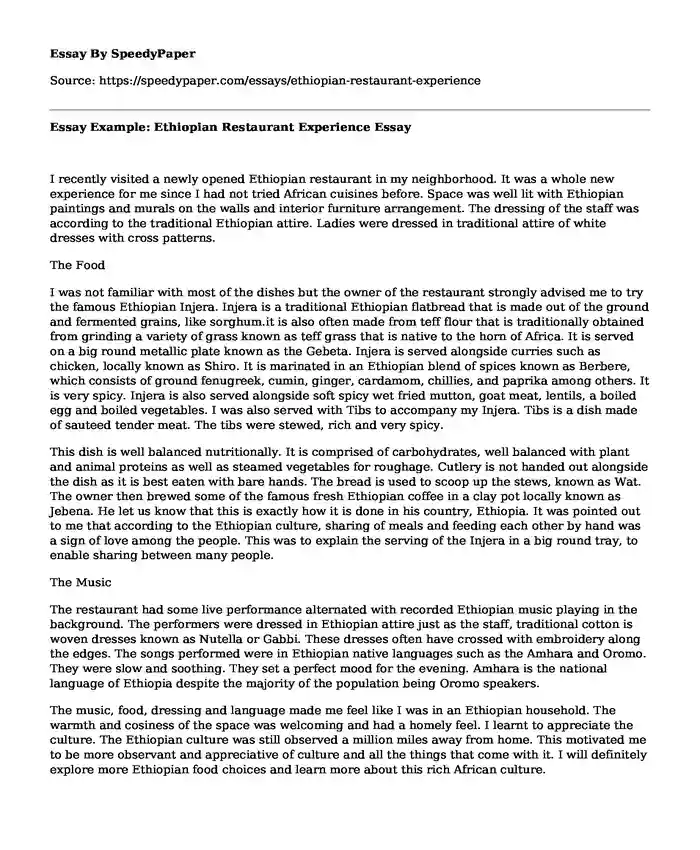
| Type of paper: | Essay |
| Categories: | Culture Cuisine Personal experience |
| Pages: | 3 |
| Wordcount: | 552 words |
I recently visited a newly opened Ethiopian restaurant in my neighborhood. It was a whole new experience for me since I had not tried African cuisines before. Space was well lit with Ethiopian paintings and murals on the walls and interior furniture arrangement. The dressing of the staff was according to the traditional Ethiopian attire. Ladies were dressed in traditional attire of white dresses with cross patterns.
The Food
I was not familiar with most of the dishes but the owner of the restaurant strongly advised me to try the famous Ethiopian Injera. Injera is a traditional Ethiopian flatbread that is made out of the ground and fermented grains, like sorghum.it is also often made from teff flour that is traditionally obtained from grinding a variety of grass known as teff grass that is native to the horn of Africa. It is served on a big round metallic plate known as the Gebeta. Injera is served alongside curries such as chicken, locally known as Shiro. It is marinated in an Ethiopian blend of spices known as Berbere, which consists of ground fenugreek, cumin, ginger, cardamom, chillies, and paprika among others. It is very spicy. Injera is also served alongside soft spicy wet fried mutton, goat meat, lentils, a boiled egg and boiled vegetables. I was also served with Tibs to accompany my Injera. Tibs is a dish made of sauteed tender meat. The tibs were stewed, rich and very spicy.
This dish is well balanced nutritionally. It is comprised of carbohydrates, well balanced with plant and animal proteins as well as steamed vegetables for roughage. Cutlery is not handed out alongside the dish as it is best eaten with bare hands. The bread is used to scoop up the stews, known as Wat. The owner then brewed some of the famous fresh Ethiopian coffee in a clay pot locally known as Jebena. He let us know that this is exactly how it is done in his country, Ethiopia. It was pointed out to me that according to the Ethiopian culture, sharing of meals and feeding each other by hand was a sign of love among the people. This was to explain the serving of the Injera in a big round tray, to enable sharing between many people.
The Music
The restaurant had some live performance alternated with recorded Ethiopian music playing in the background. The performers were dressed in Ethiopian attire just as the staff, traditional cotton is woven dresses known as Nutella or Gabbi. These dresses often have crossed with embroidery along the edges. The songs performed were in Ethiopian native languages such as the Amhara and Oromo. They were slow and soothing. They set a perfect mood for the evening. Amhara is the national language of Ethiopia despite the majority of the population being Oromo speakers.
The music, food, dressing and language made me feel like I was in an Ethiopian household. The warmth and cosiness of the space was welcoming and had a homely feel. I learnt to appreciate the culture. The Ethiopian culture was still observed a million miles away from home. This motivated me to be more observant and appreciative of culture and all the things that come with it. I will definitely explore more Ethiopian food choices and learn more about this rich African culture.
Cite this page
Essay Example: Ethiopian Restaurant Experience. (2022, Feb 22). Retrieved from https://speedypaper.net/essays/ethiopian-restaurant-experience
Request Removal
If you are the original author of this essay and no longer wish to have it published on the SpeedyPaper website, please click below to request its removal:
- Essay Example on Suggested Seizure Treatment
- Essay Sample: Cloud Computing
- HRM Essay Sample: Enhancing Creativity in the Research and Development Department
- A Perspective of Chinese College Students, Free Essay Example on the Influence of Culture
- Reflection on Bay Food Company, Free Essay in Strategic Management
- Essay Sample on Human Resource Management Concepts
- Free Essay: The Great Depression and Financial Crisis of 2008
Popular categories




